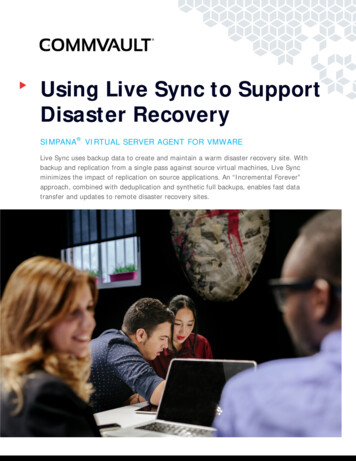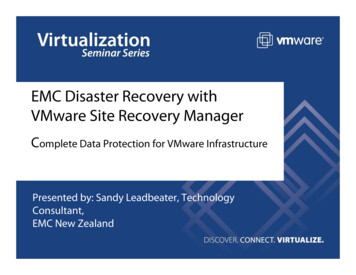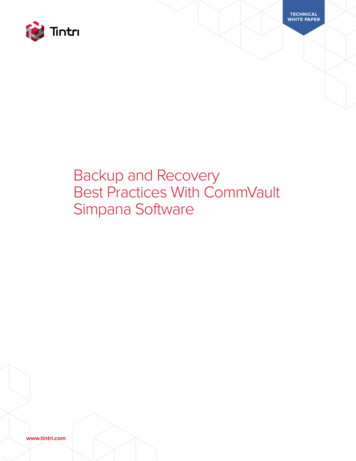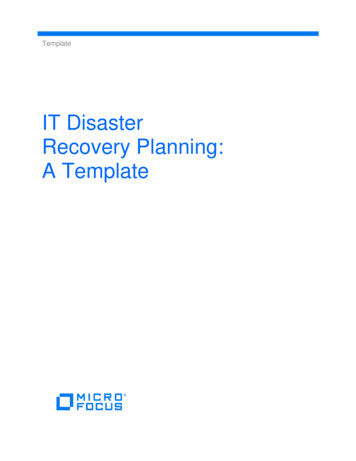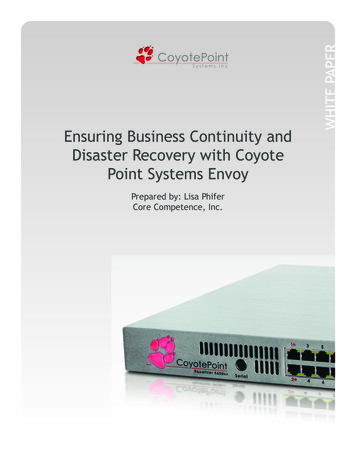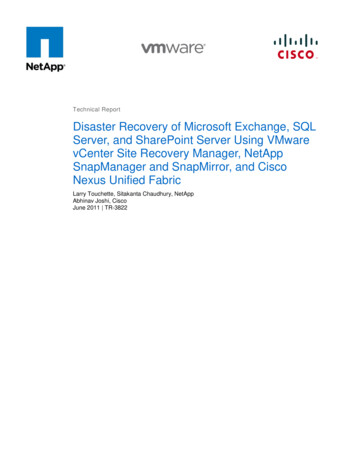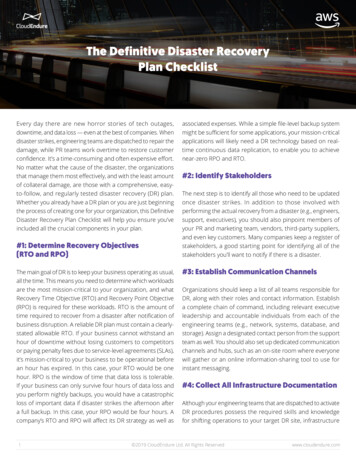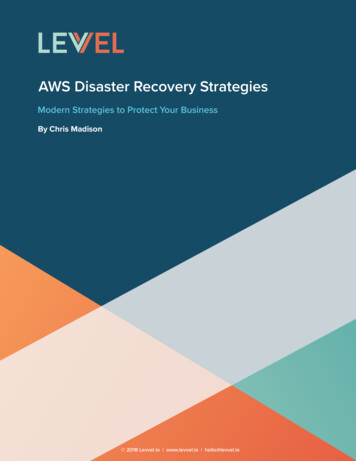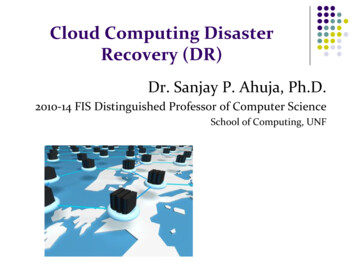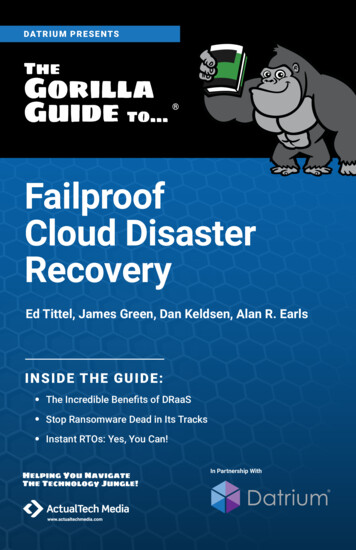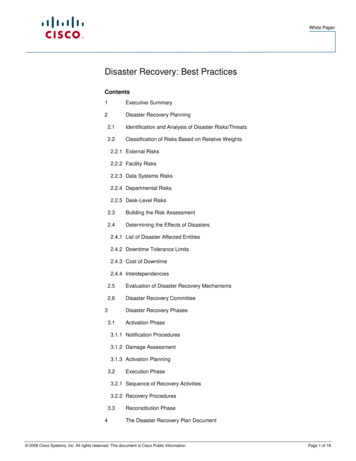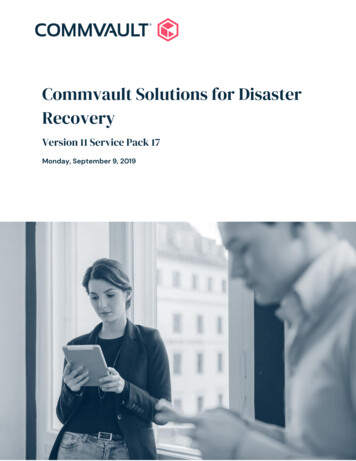
Transcription
Commvault Solutions for DisasterRecoveryVersion 11 Service Pack 17Monday, September 9, 2019
Commvault Solutions for Disaster Recovery - Version 11 Service Pack 17ContentsCommvault Solutions for Disaster Recovery . 3Multi-Tiered DR Support for Modern IT Environments .4Backup, Replication, and Orchestration .6Disaster Recovery Features for Data, Applications, and Systems .8Use Cases . 11Role-Based Management Interfaces . 15Architecture for Data Portability . 16Cross-Platform Feature Support for Live Sync Replication . 17Where to Find More Information . 21Copyright 2019 Commvault Systems, Inc. All rights reserved.2
Commvault Solutions for Disaster Recovery - Version 11 Service Pack 17Commvault Solutions for DisasterRecoveryUse Commvault to deploy powerful, flexible, and cost-effective disaster recovery (DR)solutions that maximize the value of the Commvault data protection framework.Commvault solutions for disaster recovery provide the following benefits: Replication of data and applications across physical and virtual platforms, includingon-premises deployments and public, private, or hybrid clouds. Flexible and cost-effective options to support a range of business requirements forthe modern IT environment, with different recovery point objectives (RPOs) andrecovery time objectives (RTOs) depending on the criticality of different workloads. Multiple recovery points based on backup operations, to ensure that systems areprotected against loss of access, data corruption, and external threats. Orchestration to ensure critical systems can be redeployed quickly in the event ofa disaster. Advanced data transport features for efficient data movement across networks,with data compression, deduplication, and ongoing incremental updates. Validation and testing to ensure replicated resources are ready to use in the eventof disruption. Centralized management, monitoring, reporting, and visualization, with streamlineddashboard operations, multi-tenant support, and self-service interfaces.This document is primarily concerned with disaster recovery for virtual machines.It also describes the Commvault framework for disaster recovery, provides contextabout the business requirements that drive DR strategies, and identifies relatedfeatures that might be useful in the DR planning process.Copyright 2019 Commvault Systems, Inc. All rights reserved.3
Commvault Solutions for Disaster Recovery - Version 11 Service Pack 17Multi-Tiered DR Support for Modern ITEnvironmentsDisaster recovery planning and testing are essential parts of the businessenvironment. Over a third of companies surveyed by Commvault have initiated theirdisaster recovery plans at least once, and every company is likely to need to ensurecontinuity in the face of disruption, in the form of natural events, technological failures,or human actions.Changes in IT EnvironmentsIn the past, critical data for most businesses existed in a single location or in a smallnumber of offices, and in a homogeneous environment that included a small numberof servers, operating systems, and applications. By contrast, modern IT environmentsspan multiple data types, multiple locations, and multiple platforms, from on-premisesequipment to cloud environments, and reside in servers around the globe.Copyright 2019 Commvault Systems, Inc. All rights reserved.4
Commvault Solutions for Disaster Recovery - Version 11 Service Pack 17Costs of Rapid RecoveryIn addition, the amount of data that businesses create, collect, and maintain has grownexponentially. Likewise, the cost of disaster recovery has grown, especially whenbusinesses require frequent recovery points and rapid recovery times.A one-size-fits-all approach to disaster recovery planning is not practical for modernIT environments. Instead, organizations must define DR plans that prioritize missioncritical data and applications:1. Mission-critical data and applications need to be recovered as quickly as possible,with the latest updates from production systems.2. Less critical assets can be brought back online more gradually. If updates to theoriginal data are less frequent, frequent recovery points might not be as important.3. Legacy data that is maintained for reference purposes can be recovered on an asneeded basis.Copyright 2019 Commvault Systems, Inc. All rights reserved.5
Commvault Solutions for Disaster Recovery - Version 11 Service Pack 17Aligning Budgets with Business RequirementsBy using a multi-tiered approach, organizations can deploy IT budgets to align withbusiness requirements.Backup, Replication, and OrchestrationCommvault disaster recovery solutions begin with backup operations. This approachoffers significant advantages over other types of solutions: The frequency of backup operations determines the recovery point objective(RPO).Frequent recovery points also enable recovery from an earlier point in time, in theevent that the latest data on production systems is corrupted or compromised. Bycontrast, solutions that rely entirely on replication might simply reproduce theoriginal environment with the same issues. Backup operations can create application-consistent recovery points.Solutions that rely on snapshots might require significant work, such as replayingtransaction logs, to reproduce the state of application data. Using backup data as a source for DR sites makes it possible to use backupinfrastructure for recovery, reducing the impact on production systems. By capturing data in a platform-independent form, you can avoid the need torecreate the original environment in a DR site.For example, you can recover from a physical source to a virtual destination, orfrom on-premises equipment to a public cloud.Copyright 2019 Commvault Systems, Inc. All rights reserved.6
Commvault Solutions for Disaster Recovery - Version 11 Service Pack 17 You can validate backups as they are created, without the need to maintaindestination infrastructure indefinitely.This approach can be especially useful for non-critical data that might need to beaccessed on an as-needed basis.Unparalleled ProtectionBecause Commvault uses a common data protection framework across differentsystems and applications, and leverages native capabilities on different data sources,the coverage and efficiency of Commvault backup operations is unparalleled. Forexample: Perform streaming backups directly, or use native hardware snapshots to capturedata quickly, and then use the snapshot to create a streaming backup copy. Begin with a full backup, and then use a "forever incremental" approach to captureongoing updates. When necessary, use application agents or application-aware plugins to protectcritical data. Protect different file systems, storage arrays, datastores, physical and virtualmachines, databases, cloud sites, and applications. Validate backups as they are created.Flexible and Efficient Recovery or ReplicationCommvault supports recovery on the broadest possible range of systems, platforms,and locations, and optimizes data transfers to remote sites. Recover or replicate from on-premises equipment to a public, private, or hybridcloud environment. Recover data from a physical machine to a virtual machine, or convert a VM fromone hypervisor to a different hypervisor. Create copies of data at remote sites, replicate to a warm recovery site, orconfigure real-time transactional updates to support immediate recovery. Replicate groups of virtual machines to support operations or to create a testenvironment quickly.Copyright 2019 Commvault Systems, Inc. All rights reserved.7
Commvault Solutions for Disaster Recovery - Version 11 Service Pack 17 Replicate to multiple DR sites to decrease risk. Live mount virtual machines from backups to validate backups, recover virtualmachines quickly, or access data directly from a VM. Use incremental updates, data compression, and deduplication to reduce networktransport times.Rich Orchestration FeaturesOrchestration features make it possible to validate backups, coordinate failovers, andautomate common operations: Perform test boot operations to verify that virtual machines are ready to use. Monitor or report on recovery readiness and replication activity. Schedule planned failovers to a destination site, test failovers, perform point-intime failovers, initiate unplanned failovers after disruptions, enable automaticfailovers, fail back to the production site, and undo or reverse failovers. Replicate a development and test environment or create a virtual lab.Disaster Recovery Features for Data,Applications, and SystemsCommvault provides disaster recovery features for a broad range of businessrequirement and platforms.This list will never be up to date, because we are constantly working to provide moreand better solutions!For a summary of the features that are available for each platform, see Cross-PlatformFeature Support for Live Sync Replication (on page 17)Backup and RecoveryPerform backups, and then create copies of backup data at remote sites where theycan be used for recovery as needed.Copyright 2019 Commvault Systems, Inc. All rights reserved.8
Commvault Solutions for Disaster Recovery - Version 11 Service Pack 17Live Sync Replication for VirtualizationLive sync for virtualization uses backup data from source VMs to create VMs at one ormore destination sites. Destination sites can use the same hypervisor as the source, orcan convert VMs to run on a different hypervisor. You can create VMs from a fullbackup, then apply updates from incremental backups to keep destination VMs insync with source VMs. Live sync includes orchestration features that enable rapidrecovery at a destination site. You can use live sync to replicate single VMs or largegroups of VMs.Commvault provides the following live sync features for virtualization: Live Sync: From streaming backups or backup copies, identify VMs to replicate,configure settings for destination VMs (such as destination network settings),create VMs from backups, apply ongoing updates from incremental backups,monitor replication activity, and orchestrate testing and recovery operations. Live Sync Direct: From IntelliSnap backups, replicate VMs directly from a hardwareor software snapshot, apply ongoing updates from incremental backups, and useother features from basic live sync. Live Sync I/O: For transaction-based replication, capture VM writes in real timeand replicate them to the destination site. Continuously update destination VMs ormaintain granular recovery points.Other Virtualization Features Dev-Test Groups: Create a virtual lab from a backup or replication job and thenuse it to validate job content. Failover groups: Identify groups of VMs to recover to a destination site. Live mount: Live mount virtual machines from backups to validate backups,recover virtual machines quickly, or access data directly from a VM.Copyright 2019 Commvault Systems, Inc. All rights reserved.9
Commvault Solutions for Disaster Recovery - Version 11 Service Pack 17Live Sync for Databases Live Sync Replication of DB2 Databases Live Sync Replication of SQL Server Databases Live Sync Replication of Oracle Databases Live Sync Replication of Oracle RAC Databases Live Sync Replication of PostgreSQL DatabasesLive Sync for the CommServe System High Availability CommServe Host (also called CommServe LiveSync): Keep theCommServe server ready for disaster recovery and provides the ability to quicklyfailover to a designated standby host in the event of a disaster.Replication for File Systems Block-Level Replication (also called Live Sync for File Systems): Back up filesystem data, replicate block-level extents to one or more destination computers,and apply ongoing updates from incremental backups. ContinuousDataReplicator (CDR): Replicates data from a source computer to adestination computer. This is done in near real-time by logging all file write activityto a replication log in the source computer, including new files and changes toexisting files. These replication logs are transferred to the destination computerand replayed, ensuring that the destination remains a nearly real-time replica ofthe source.Features for Cloud Applications Oracle Database Application Migration to Oracle Cloud Classic, Oracle CloudInfrastructure, or Amazon EC2 Backup and Recovery for:o Alibaba RDSo Amazon RDSo Amazon S3o Amazon Web Serviceso Azure Blob StorageCopyright 2019 Commvault Systems, Inc. All rights reserved.10
Commvault Solutions for Disaster Recovery - Version 11 Service Pack 17o Google Cloud Databaseo Google Cloud Storageo Google Mail and Google Driveo Microsoft OneDrive for Businesso Microsoft SQL Server (on Azure or Amazon RDS)o OpenStack Swifto Oracle Cloud Classico Oracle Cloud Infrastructureo Oracle PaaSo Oracle Storageo SalesforceUse CasesLive Sync replication provides a warm disaster recovery solution that can be used forindividual VMs or for large numbers of VMs. You can provide a DR site using onpremises equipment or using a public cloud site. Live Sync Direct uses hardware orsoftware snapshots for replication.For workloads that require very low RPOs and RTOs, you can use Live Sync I/O tocapture VM writes and replicate them to a DR site for near real-time replication.For less critical workloads, you can copy backup data and stage it at a DR site forrecovery on an as-needed basis.Live Sync to a Warm Disaster Recovery SiteLive Sync replication uses full backups to create virtual machines at one or more DRsites, and then uses incremental backups to update destination VMs on an ongoingbasis. You can configure schedules to update destination VMs immediately after eachbackup, or on a regular schedule. You can also spread the workload to use multiplestreams when updating multiple VMs simultaneously.Copyright 2019 Commvault Systems, Inc. All rights reserved.11
Commvault Solutions for Disaster Recovery - Version 11 Service Pack 17Live Sync includes orchestration features to perform test boots, failovers, failbacks,and other operations that enable you to test the DR site or move operations betweenthe primary site and a destination site.Copyright 2019 Commvault Systems, Inc. All rights reserved.12
Commvault Solutions for Disaster Recovery - Version 11 Service Pack 17Live Sync I/O for Synchronous ReplicationFor VMware environments that require very fast recovery with the latest transactiondata, you can configure Live Sync I/O. Live Sync I/O uses VMware vSphere APIs for I/OFiltering (VAIO) to capture block-level changes to source VMs and stream the changesto destination VMs continuously. You can configure Live Sync I/O to maintain thelatest version of each VM at the destination site, or to maintain a series of applicationconsistent recovery points for each VM at the destination site.Copyright 2019 Commvault Systems, Inc. All rights reserved.13
Commvault Solutions for Disaster Recovery - Version 11 Service Pack 17Remote Staging for On-Demand RecoveryFor less critical VMs, you can create auxiliary copies and send them to remote sites,using data compression and deduplication to maximize transfer speeds. As needed,you can recover VMs at the destination sites automatically or manually.Recovery Options to Match Business RequirementsFor different classes of virtual machines, you can choose the solution that matchesyour requirements.Copyright 2019 Commvault Systems, Inc. All rights reserved.14
Commvault Solutions for Disaster Recovery - Version 11 Service Pack 17Role-Based Management InterfacesYou can access Commvault software in different ways, depending on the operationsyou need to perform and the degree to which you need to customize yourconfiguration. Command Center is a web-based interface for quick deployment and dailyoperations. It uses smart defaults to simplify configuration, provides dashboardsfor operational control, and can be customized to support specific user roles. CommCell Console provides advanced features for configuration and operations. Itsupports managed service providers (MSPs) and organizations that need finegrained control for data protection operations. Web Console is a web-based interface for end users. It provides self-serviceaccess to backup and recovery data for physical and virtual machines. Programmatic access to Commvault software is available through command-lineoperations, REST APIs, and other developer tools. Third-party plugins enable users to access Commvault from within otherapplications, such as ServiceNow, vRealize or the vSphere Web Client.Copyright 2019 Commvault Systems, Inc. All rights reserved.15
Commvault Solutions for Disaster Recovery - Version 11 Service Pack 17Architecture for Data PortabilityCommvault is designed to protect data using a common framework across differentplatforms and applications. This architecture provides a foundation that supports theevolving needs of organizations moving into the future.The Commvault architecture provides comprehensive coverage and supportsemerging technologies. Platform independence: Protect and recover data across physical and virtualplatforms. Move data and applications from on-premises equipment to the cloud,and back again. Enterprise coverage: Include different operating systems, applications, devices,storage arrays, and cloud platforms in an integrated management and operationalframework. Policy-driven automation: Define policies to support operational objectives andenable streamlined operations with automation. Scalability: Flexible infrastructure for efficient management of massive collectionsof data. Built for recovery: Enable rapid recovery from outages, natural disasters, andransomware attacks. Compliance and risk management: Manage compliance with informationgovernance policies. Monitor and report on operations and data storage. Analytics: Find data and extract insights for better data governance and businessoutcomes.Copyright 2019 Commvault Systems, Inc. All rights reserved.16
Commvault Solutions for Disaster Recovery - Version 11 Service Pack 17Cross-Platform Feature Support for LiveSync ReplicationThe following table shows supported source and destination sites and supportedfeatures for Command Center and CommCell Console.SourceDestinationAzure streamingbackupsAzureCommand Centersupported features Failovergroups Planned orunplannedfailover Azure Vstreamingbackups orbackup copiesOpenStackAzure StackAzureHyper-VOpenStackCommCell Consolesupported features Planned orunplannedfailover Failback Planned orunplannedfailover Failback Planned orunplannedfailover Failback Test boot Planned orunplannedfailoverFailbackNot supported Failovergroups Planned orunplannedfailover Failback Failovergroups Test boot Planned orunplannedfailover Failback Planned orunplannedfailoverNot supportedCopyright 2019 Commvault Systems, Inc. All rights reserved.17
Commvault Solutions for Disaster Recovery - Version 11 Service Pack 17SourceDestinationOracle CloudInfrastructurestreamingbackupsOracle eamingbackupsAmazonAzureCommand Centersupported features Failovergroups Planned orunplannedfailover Undo failover Failovergroups Planned orunplan
sync with source VMs. Live sync includes orchestration features that enable rapid recovery at a destination site. You can use live sync to replicate single VMs or large groups of VMs. Commvault provides the following live sync features for virtualization: Live Sync: From strea
